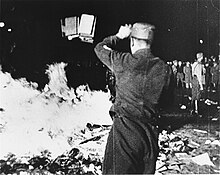
Back Boekverbranding in Nazi-Duitsland Afrikaans عمليات حرق الكتب النازية Arabic Crema de llibres a l'Alemanya nazi Catalan Pálení knih nacisty Czech Nazisternes bogbrænding Danish Bücherverbrennung 1933 in Deutschland German Bruligo de libroj en Nazia Germanio Esperanto Quema de libros en la Alemania nazi Spanish کتابسوزان نازیها Persian Autodafés de 1933 en Allemagne French


The Nazi book burnings were a campaign conducted by the German Student Union (German: Deutsche Studentenschaft, DSt) to ceremonially burn books in Nazi Germany and Austria in the 1930s. The books targeted for burning were those viewed as being subversive or as representing ideologies opposed to Nazism. These included books written by Jewish, half-Jewish, communist, socialist, anarchist, liberal, pacifist, and sexologist authors among others.[1] The initial books burned were those of Karl Marx and Karl Kautsky,[2] but came to include other authors, including Albert Einstein, Helen Keller, writers in French and English, and effectively any book incompatible with Nazi ideology. In a campaign of cultural genocide, books were also burned en masse by the Nazis in occupied territories, such as in Poland.[3]
- ^ "Book Burning". History Unfolded: US Responses to the Holocaust. United States Holocaust Memorial Museum.
- ^ Strätz, Hans-Wolfgang (1968). Die studentische "Aktion wider den undeutschen Geist" im Frühjahr 1933. In: Vierteljahrshefte für Zeitgeschichte, 16 (in German). pp. 347–353.
- ^ Hench, John B. (2010) Books As Weapons, p. 31. Ithaca, NY: Cornell University Press. ISBN 978-0-8014-4891-1